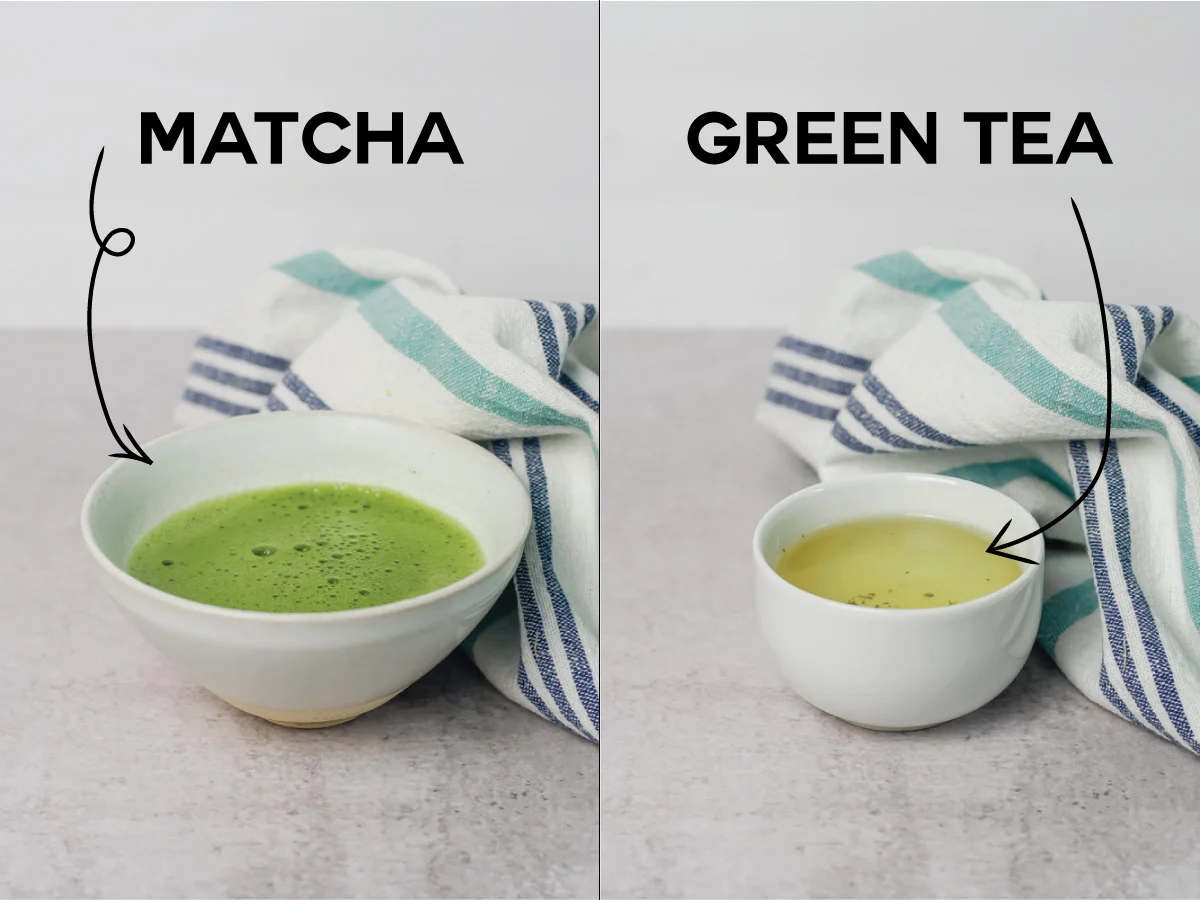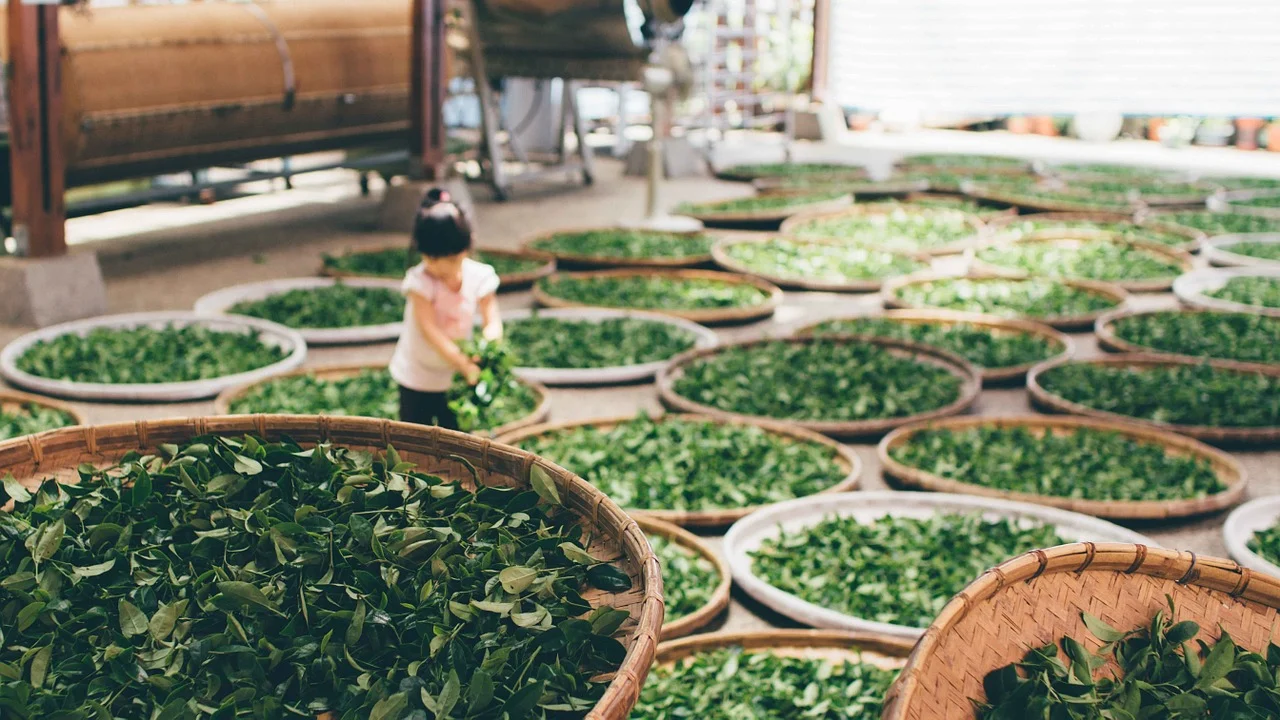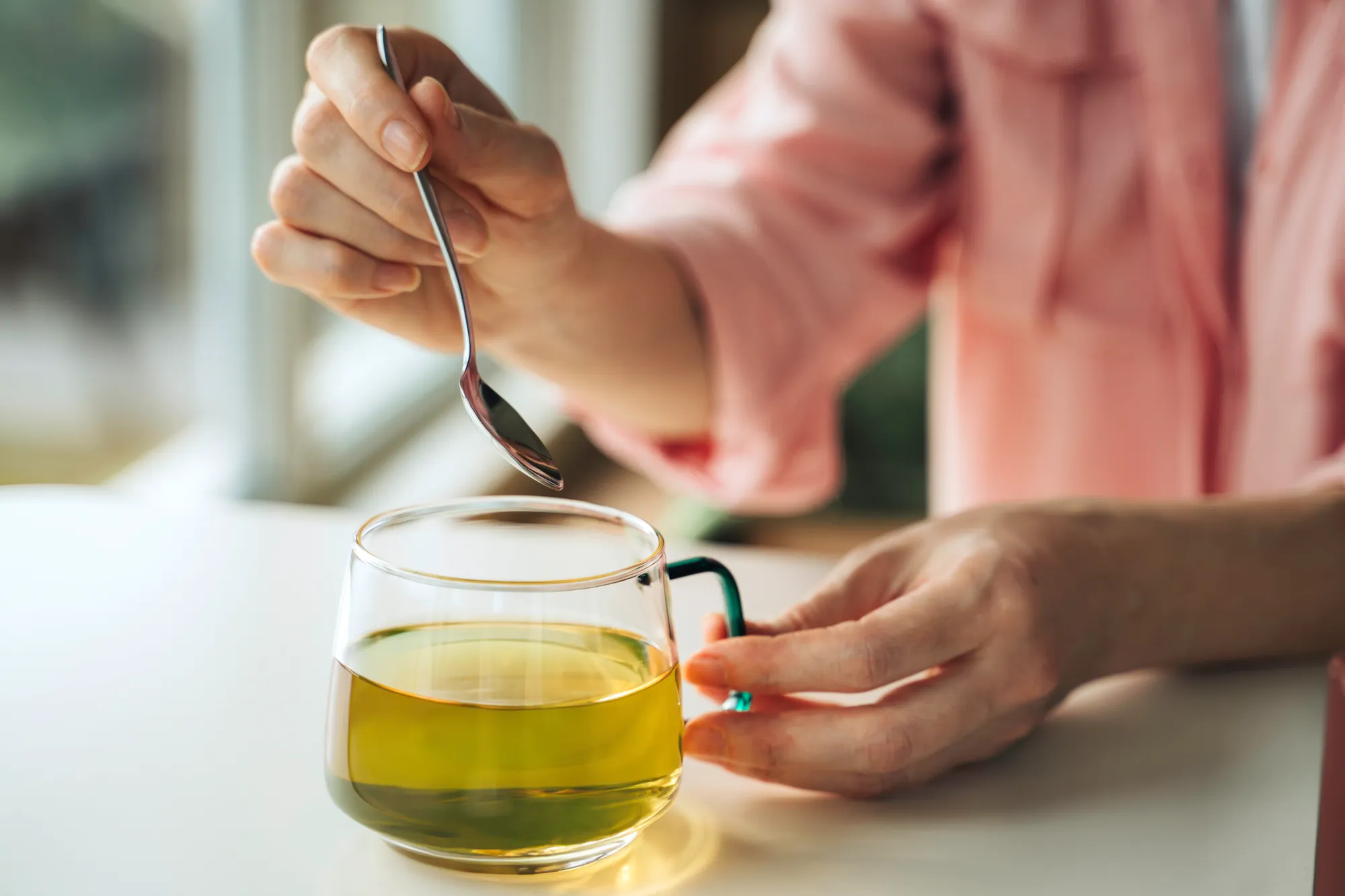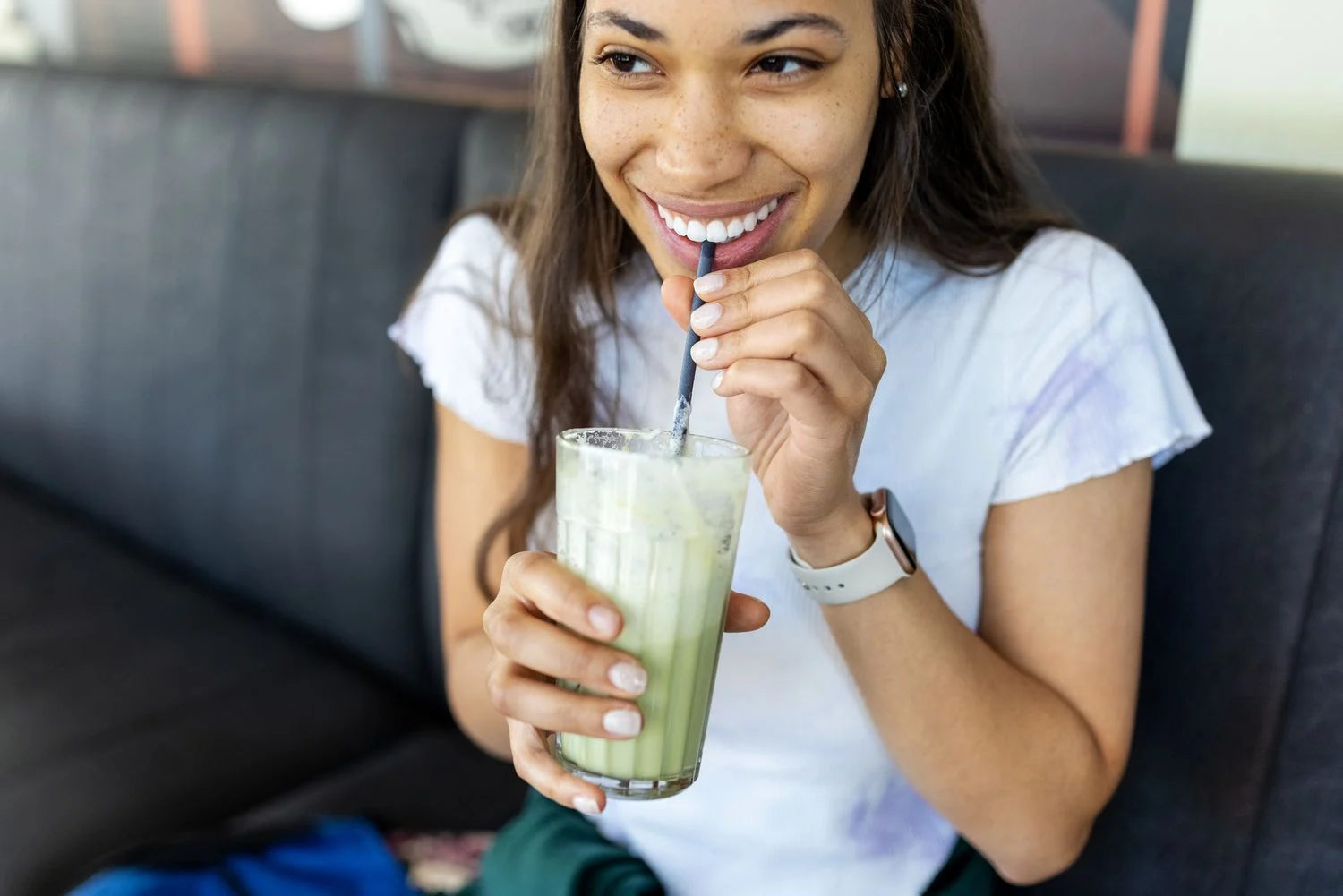It’s a question many health-conscious individuals and tea lovers ask: matcha vs. green tea—what’s really the difference? Both are celebrated for their health benefits, both are green, and both originate from the same plant. Yet, they stand worlds apart in terms of flavor, nutrition, and preparation.
While they share a common ancestor, the Camellia sinensis plant, thinking they are the same is like confusing a grape with a fine wine. One is the raw ingredient; the other is the product of a meticulous, artful process.

This guide will walk you through every critical difference, from how they are grown and processed to their unique nutritional profiles and health benefits. By the end, you’ll know exactly which green brew is the right choice for your lifestyle and wellness goals.
At a Glance: Matcha vs. Green Tea Comparison Table
For a quick overview, here’s a side-by-side look at what sets matcha and green tea apart.
| Feature | Matcha | Green Tea |
|---|---|---|
| Plant Source | Camellia sinensis | Camellia sinensis |
| Cultivation | Shade-grown for 3-4 weeks before harvest | Sun-grown |
| Processing | Steamed, de-veined, de-stemmed, stone-ground | Steamed or pan-fired, rolled, dried |
| Form | Fine, vibrant green powder | Whole or partial dried leaves |
| Flavor Profile | Rich, creamy, umami, slightly sweet | Light, vegetal, grassy, sometimes astringent |
| Caffeine | High (approx. 35-70 mg per gram) | Low to Medium (approx. 20-45 mg per 8oz cup) |
| L-Theanine | Very High | Moderate |
| Antioxidants (EGCG) | Exceptionally High | High |
| Preparation | Whisked with hot water to form a suspension | Steeped in hot water, leaves are discarded |
| Cost | Higher | Lower |
The Core Difference: You Drink the Leaf vs. an Infusion
The single most important distinction between matcha and green tea lies in what you consume.
When you brew a cup of traditional green tea, you are steeping the leaves in hot water and then discarding them. The water becomes infused with some of the leaves’ nutrients and flavor compounds, but a significant portion remains locked away in the plant fiber. It’s like boiling spinach, drinking the water, and throwing the spinach away. You get some benefits, but you miss out on the full nutritional payload.
Matcha, on the other hand, is the whole leaf. The leaves are stone-ground into an ultra-fine powder. When you prepare matcha, you whisk this powder into water, meaning you consume the entire leaf. This fundamental difference is the reason for matcha’s vibrant color, potent nutritional profile, and higher price tag.
From Farm to Cup: How Cultivation and Processing Create Two Different Teas
The journey from a tea plant to your cup is where matcha and green tea truly diverge. Their unique characteristics are born from centuries-old agricultural and processing techniques.
Shaded vs. Sun-Grown: The First Major Split
The first deviation happens weeks before the tea leaves are even picked.
- Matcha: About 20 to 30 days before harvest, the tea plants destined to become matcha are covered with shade cloths. This deprivation of direct sunlight forces the plants to overproduce chlorophyll (making the leaves a darker, richer green) and amino acids, most notably L-theanine. This is the secret to matcha’s signature umami flavor and its calming mental effects.
- Green Tea: In contrast, green tea plants are left to grow in direct sunlight until harvest. This promotes the production of catechins (like EGCG), which contribute to its sometimes more astringent or bitter taste.

Steaming, Grinding vs. Rolling, Drying: The Processing Path
After harvesting, their paths diverge completely.
- Matcha: The leaves are quickly steamed to halt oxidation and preserve their vibrant color and nutrients. Then, in a painstaking process, the stems and veins are removed, leaving only the tender leaf flesh, known as tencha. This tencha is then slowly stone-ground, often in the dark, by granite mills into a powder as fine as talc. It can take an hour to grind a single ounce of high-quality matcha.
- Green Tea: The leaves are also steamed (Japanese style) or pan-fired (Chinese style) to prevent oxidation. Afterward, they are rolled into various shapes (needles, twists, pellets) and then dried. The rolling process helps shape the leaves and influences the final flavor profile when they are steeped.
Nutritional Showdown: A Head-to-Head Comparison
Because you consume the entire leaf, matcha delivers a much more concentrated dose of the nutrients found in green tea.
Caffeine Content: Which Gives a Better Buzz?
If you’re looking for an energy boost, this is a key comparison. A typical serving of matcha contains significantly more caffeine than a cup of green tea.
- Matcha: Roughly 35-70 mg of caffeine per gram (a typical serving is 1-2 grams).
- Green Tea: Roughly 20-45 mg of caffeine per 8-ounce cup.
However, the matcha vs green tea caffeine story isn’t just about quantity; it’s about quality. The high concentration of L-theanine in matcha creates a unique synergy with caffeine. L-theanine is an amino acid that promotes relaxation and focus without drowsiness. It slows the body’s absorption of caffeine, leading to a sustained, calm alertness for 3-6 hours, rather than the sharp spike and subsequent crash often associated with coffee.
Antioxidant Powerhouse: The EGCG Factor
Both teas are rich in powerful antioxidants called catechins, with the most famous being Epigallocatechin gallate (EGCG). These compounds help fight oxidative stress and protect cells from damage.
Because matcha is made from the whole leaf, it contains a much more concentrated amount of EGCG. Some studies suggest that matcha may have several times the amount of EGCG found in regular brewed green tea. This makes it a potent tool for supporting overall health and cellular integrity.
L-Theanine: The Secret to “Calm Alertness”
As mentioned, L-theanine is the star player responsible for matcha’s unique mental benefits. The shade-growing process dramatically increases its concentration. While regular green tea also contains L-theanine, matcha has a much higher amount, making it superior for enhancing focus, reducing stress, and improving mood.
Health Benefits: Is Matcha Truly “Healthier”?
While both teas are incredibly healthy, the concentrated nature of matcha means its benefits are often amplified.
- Boosted Brain Function: The combination of caffeine and L-theanine is a cognitive powerhouse, shown to improve attention, reaction time, and memory.
- Enhanced Metabolism and Weight Management: The high levels of EGCG in matcha have been linked to boosting metabolism and increasing fat burning, making it a popular choice for those on a weight loss journey.
- Liver and Heart Health: Green tea, in general, is associated with protecting the liver and supporting cardiovascular health. Matcha’s concentrated dose of these protective compounds may offer enhanced benefits.
- Skin Health and Detoxification: The high chlorophyll content from shade-growing gives matcha powerful detoxifying properties, helping to eliminate heavy metals and toxins from the body. Its antioxidants also help fight skin inflammation and aging.
In short, while any green tea is a great addition to your diet, matcha is a supercharged version.

Flavor, Preparation, and Cost: The Practical Differences
Taste Profile: Umami vs. Vegetal Notes
- Matcha: High-quality matcha has a complex flavor profile. It’s smooth, creamy, and anchored by a savory, brothy taste known as umami. This is balanced by a subtle, natural sweetness and a pleasant, lingering finish. Poor quality or improperly prepared matcha can be quite bitter.
- Green Tea: The taste of green tea varies widely by type. It’s generally lighter and more refreshing, with notes described as grassy, vegetal, nutty, or oceanic.
How to Prepare Them: Whisking vs. Steeping
- Matcha: Authentic preparation is a ritual. You sift the matcha powder into a bowl (chawan), add hot (not boiling, about 175°F/80°C) water, and use a bamboo whisk (chasen) to vigorously whisk the mixture in a ‘W’ or ‘M’ motion until a fine, creamy froth forms on top.
- Green Tea: Preparation is simpler. You place the tea leaves in a pot or infuser and pour hot water over them. The steeping time and temperature vary by tea type, but it’s typically 1-3 minutes. Afterward, the leaves are removed.
The Price Tag: Why Is Matcha More Expensive?
The difference in price between matcha and green tea is a direct reflection of the labor and care involved in its production. The shade-growing, hand-harvesting, meticulous de-stemming and de-veining, and the slow, specialized stone-grinding process all contribute to its higher cost.
So, Which One Should You Choose?
There’s no single “better” tea—only the one that’s better for you.
✅ Choose Matcha if…
- You are looking for a potent coffee alternative that provides sustained, jitter-free energy.
- You want to maximize your intake of antioxidants, L-theanine, and other nutrients.
- You enjoy a rich, creamy, umami flavor and appreciate the mindful ritual of preparation.
- Your primary goal is enhanced focus, metabolism, or detoxification.
✅ Choose Green Tea if…
- You prefer a lighter, more subtle, and refreshing tea experience.
- You are more sensitive to caffeine or want a beverage you can drink more freely throughout the day.
- You are working with a tighter budget.
- You enjoy exploring variety, as there are hundreds of types of green tea (like Sencha, Gyokuro, and Bancha) with distinct flavors.
Frequently Asked Questions (FAQ)
Is matcha just powdered green tea?
No. This is a common misconception. Standard green tea powder is made by simply grinding up regular green tea leaves. Matcha comes from shade-grown, de-stemmed, and de-veined tencha leaves, resulting in a finer texture, brighter color, and completely different nutritional and flavor profile.
Can I use green tea powder for a latte instead of matcha?
You could, but the result would be very different. It would lack the creamy texture, vibrant color, and umami depth of a true matcha latte. It would likely taste much more bitter and gritty.
How much matcha is safe to drink per day?
For most adults, 1-2 servings (1-2 grams per serving) of matcha per day is considered safe and beneficial. Due to its potent caffeine and nutrient content, it’s best to enjoy it in moderation.
Does the quality of matcha really matter?
Absolutely. There are two main grades: Ceremonial Grade, which is the highest quality, meant for traditional preparation with just water, and Culinary Grade, which has a stronger, more robust flavor suitable for lattes, smoothies, and baking. Ceremonial grade will be less bitter and have a more vibrant color.
The Final Word
Both matcha and green tea are fantastic, healthy beverages derived from the same remarkable plant. Green tea is an accessible, refreshing, and wonderfully healthy daily drink. Matcha is its more potent, concentrated, and ceremonial sibling, offering an amplified dose of nutrients and a unique experience of calm, focused energy.
The choice isn’t about which is superior, but which aligns best with your personal taste, health goals, and desired experience. Why not try both and see which one wins a place in your daily ritual?



